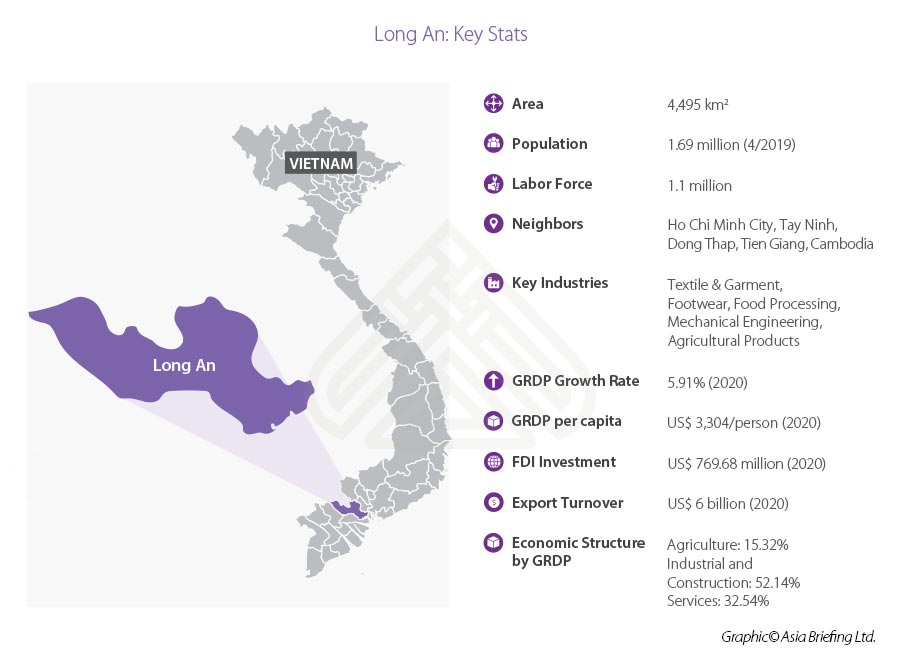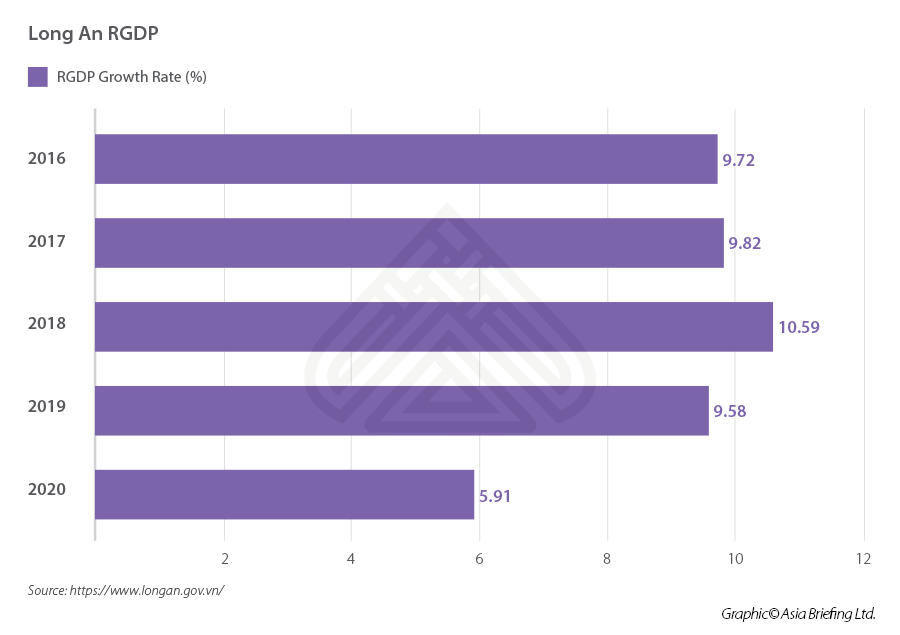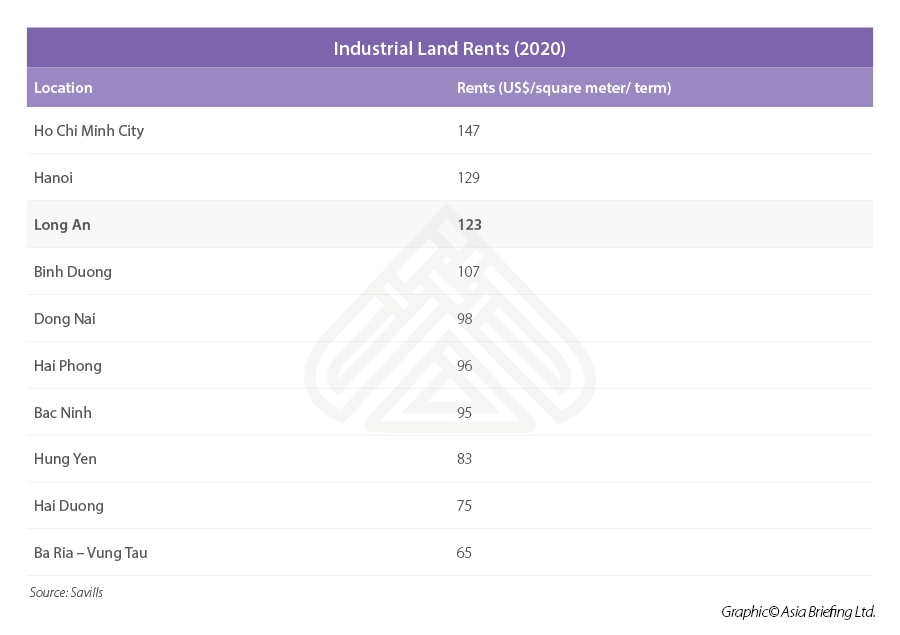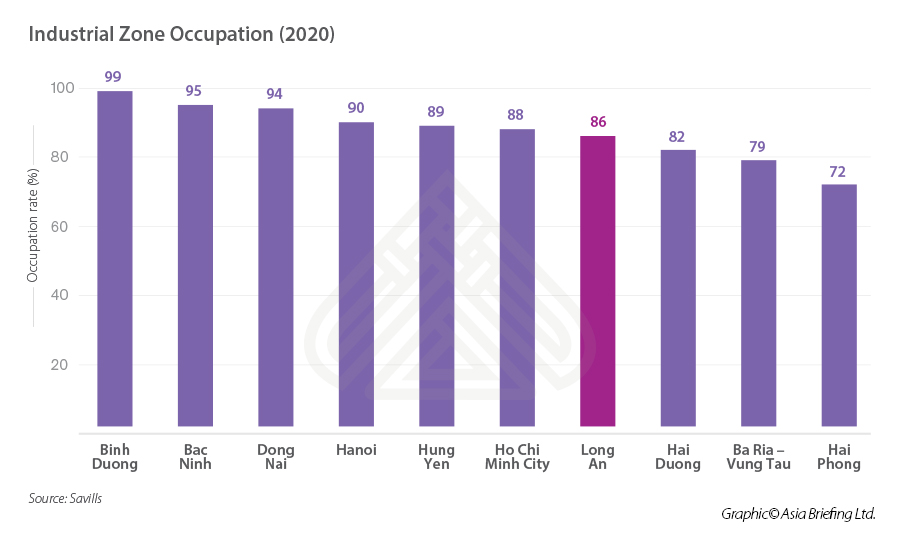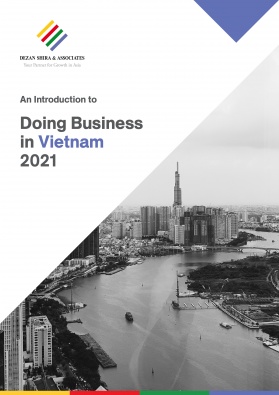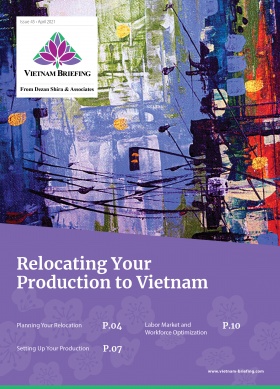Long An – A Promising Investment Hub in Southern Vietnam
- As a gateway linking Ho Chi Minh City and the Mekong Delta region, Long An province is an ideal location to be an investment magnet in the southern economic center of Vietnam.
- The province’s exponential economic growth, large industrial land area, improving infrastructure, and effective administrative system are vital components of its growing FDI attractiveness.
- Recently, the provincial authorities proposed to develop a 32,000 hectare super economic zone. The project, once completed, will be one of the largest economic zones in Southern Vietnam.
Bordering Cambodia and acting as a gateway connecting Ho Chi Minh City and the Mekong Delta region, Long An province is an ideal location for investors to access Vietnam’s two economic hubs, the Southern Key Economic Region (SKER) and the Mekong Delta in the South of Vietnam.
Building on the back of limited industrial land in the SKER, Long An has emerged as a new hub for domestic and foreign investment due to its geographic location, exponential economic growth, abundant industrial area, developing infrastructure, and improving regulatory environment.
Vietnam Briefing examines the investment climate of Long An and key factors that make it competitive for investors.
Long An’s economic profile
Compared to other localities of the SKER, Long An remains an agricultural-based province in which agriculture accounts for 71 percent of the total land in the province.
However, the provincial economic structure is shifting toward industrial activities, recording an average growth rate of 14.9 percent over the past five years, compared to 5.84 percent growth in the service sector and 1.98 percent in the agricultural sector.
In 2020, the proportion of the agriculture, industry and construction, and service sectors making up the provincial economic structure was 15.32 percent, 52.14 percent, and 32.54 percent respectively. Among these, food processing is the predominant industry, accounting for 98 percent of the province’s industrial structure, alongside supporting industries.
In 2020, Long An’s GDP reached US$5.7 billion, increasing by 5.91 percent despite COVID-19. The regional gross domestic product (RGDP) per capita stood at US$3,304 per person per year. While Long An’s RGDP remains relatively modest compared to other localities in the SKER, the province is catching up and steadily establishing itself as an important engine for economic growth in Southern Vietnam.
Long An’s 2020 export turnover reached US$6 billion and experienced a 0.5 percent growth rate over the same period. Foreign-invested enterprises continue to contribute the larger part (73 percent) to the sum, with main export goods such as textile and apparel, leather shoes, electronics, mechanics, iron and steel, and agricultural products such as rice, cashew nuts, and seafood. Key export markets of the province are Taiwan, South Korea, Japan, Hong Kong, and the US.
Foreign investment landscape
Long An has steadily emerged as a hub for foreign investment, especially in food processing, textile and garment, supporting industries, and most recently green energy.
At the end of 2020, Long An received nearly 1,100 FDI projects with a total capital of over US$6.6 billion. Meanwhile, in the first 11 months of 2020, the province recorded 106 new foreign-invested projects with US$769.68 million total registered capital (includes US$289.3 million newly registered capital, US$301,96 million additional registered capital, and US$178.39 capital contribution and share purchase).
As a latecomer for attracting FDI, the share of Long An in Vietnam’s foreign direct investment inflow is quite modest by regional standards. However, as the province consistently improves its investment environment, develops infrastructure, and enlarges its industrial land, the province has steadily climbed up the FDI ladder.
Last year, the province ranked ninth nationally for FDI attraction by location, surpassing many ‘worthy opponents’ such as Dong Nai, Hai Duong, and Thai Nguyen provinces. The province also ranks third in Vietnam’s 2020 Provincial Competitiveness Index (PCI), reflecting the effectiveness of its economic and investment governance compared to 62 other provinces across the country, as well as the province’s increased attractiveness as a favorable destination for investment.
In Q1 2021, Long An established itself as a spotlight in Vietnam’s FDI due to the Long An I and II liquefied natural gas (LNG)-fired power plants project having total registered capital of more than US$3.1 billion by a Singapore investor, VinaCapital GS Energy Pte. Ltd.
This green energy project is by far the largest FDI project in Long An and aligns with the province’s FDI attraction plan that prioritizes investment in green energy, in addition to its traditional sectors such as processing and supporting industries.
Apart from this exciting project, most of the FDI projects of the province are in footwear, textile and apparel, and other labor-intensive industries. Matching with its key export markets, Taiwan, South Korea, Singapore, Japan, Hong Kong, and the US are also the top investors in the province. Besides VinaCapital GS Energy, Huafu Textile Factory from Hong Kong, and Trillions Company, a member of Fushan Group are big investors in the province.
Transport infrastructure review
Despite its strategic location, the transportation system in Long An is yet to keep pace with its regional connectivity role and growth potential. While there are various important roads that connect the province, such as Ho Chi Minh City-Trung Luong expressway, key national highways 1A, 50, 62, N2, and provincial route 10, traffic congestion usually occurs due to significant traffic to and from Ho Chi Minh City.
As such, developing transport infrastructure has been made a top priority by the provincial authorities. Numerous infrastructure projects have been planned and executed to step up the province’s road traffic system. For the 2021-25 period, the province expects to mobilize US$1.3 billion to develop 11 roads connecting the province and Ho Chi Minh City, the upcoming Long Thanh international airport in Dong Nai province, as well as Long An international port.
Apart from the road system, Long An also sees strong potential to grow its waterway transportation and make it a crucial part of the provincial logistics network. From Long An, ships with more than 100 tonnes can follow canals such as Phuoc Xuyen, Duong Van Duong, Tra Cu, and Kinh Xang; as well as Ben Luc and Rach Cat river to go to Ho Chi Minh City.
Long An international port, with a capacity of 15,000 tons, is an important engine to drive the province forward as an important import and export hub. The port is currently being expanded and is expected to be completed by 2023, increasing its capacity to over 80 million tons of cargo per year and further helping reduce traffic congestion and logistics costs.
Expanding industrial zones
Long An has 26 industrial zones that have been granted investment licenses with total industrial land of more than 8,613 hectares. However, there are 16 out of 26 industrial zones in operation with total industrial land of 2,324 hectares, among which 87.63 percent is occupied. The price for industrial land rent in Long An increased to US$123 per square meter last year due to rising demand for industrial land, ranking third domestically after Ho Chi Minh City and Hanoi.
To capture the tremendous growth potential of the province, Long An’s authorities proposed to develop a 32,000 hectares super economic zone in the period 2021-2030 and with a vision to 2050. The project, namely the Long An Economic Zone, once completed, will be one of the largest economic zones in Southern Vietnam as per global standards. This industrial zone is planned to be a new hub for electronics, robotics, and automation, agritech and biotech, biofuels, biochemistry, and healthcare.
Besides, Long An also has 22 operating industrial clusters with 77.6 percent being occupied and 38 developing clusters with a total area of 1,862.9 hectares.
Takeaways
As industrial land in the SKER becomes limited, Long An’s large industrial land, improving infrastructure, and advantageous location have made the province the next top destination for investment in Southern Vietnam.
Various opportunities have emerged as Long An plans to become a new industrial hub for high-tech and high-value industries, in addition to its traditional strengths in textile and garment, footwear, and food processing. Besides, the province’s aggressive infrastructure development plan also opens opportunities for investors looking to invest through public-private partnership projects.
With holistic efforts, Long An is on the right track to keep pace with Binh Duong, Dong Nai, and other provinces in the SKER in RGDP and FDI inflow, promising to play a leading role in driving the development of this key economic center in the long term.
About Us
Vietnam Briefing is produced by Dezan Shira & Associates. The firm assists foreign investors throughout Asia from offices across the world, including in Hanoi, Ho Chi Minh City, and Da Nang. Readers may write to vietnam@dezshira.com for more support on doing business in Vietnam.
We also maintain offices or have alliance partners assisting foreign investors in Indonesia, India, Singapore, The Philippines, Malaysia, Thailand, Italy, Germany, and the United States, in addition to practices in Bangladesh and Russia.
- Previous Article Vietnam Unveils Support for Vocational Training: Decision 17
- Next Article Vietnam’s Wine Industry and Opportunities for Australian Investors

























